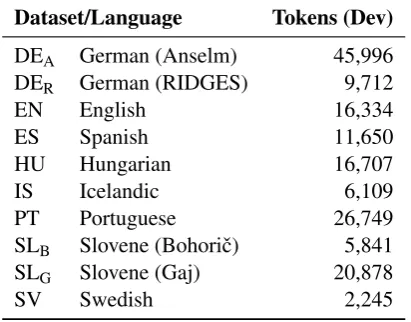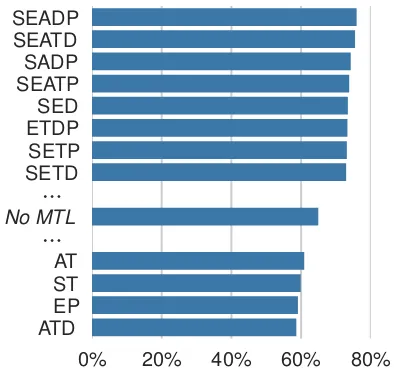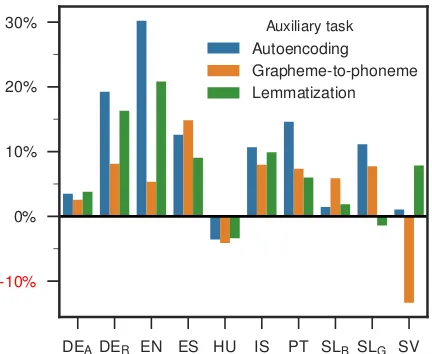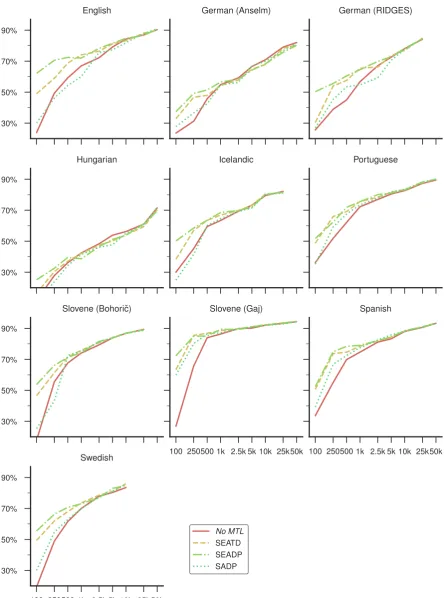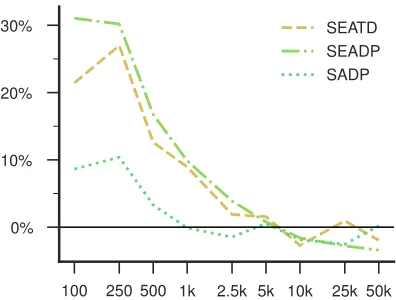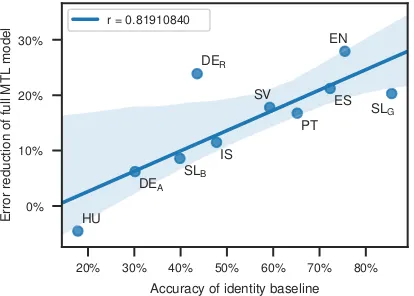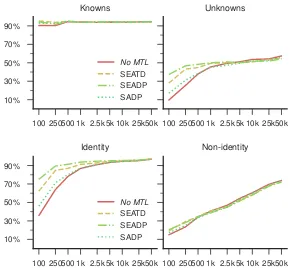Proceedings of the 2nd Workshop on Deep Learning Approaches for Low-Resource NLP (DeepLo), pages 104–114 Hong Kong, China, November 3, 2019. c2019 Association for Computational Linguistics
104
Few-Shot and Zero-Shot Learning for Historical Text Normalization
Marcel Bollmann♣ and Natalia Korchagina♢ and Anders Søgaard♣
♣
Department of Computer Science, University of Copenhagen ♢
Institute of Computational Linguistics, University of Zurich
marcel@di.ku.dk, korchagina@ifi.uzh.ch, soegaard@di.ku.dk
Abstract
Historical text normalization often relies on small training datasets. Recent work has shown that multi-task learning can lead to significant improvements by exploiting syn-ergies with related datasets, but there has been no systematic study of different multi-task learning architectures. This paper eval-uates 63 multi-task learning configurations for sequence-to-sequence-based historical text normalization across ten datasets from eight languages, using autoencoding, grapheme-to-phoneme mapping, and lemmatization as aux-iliary tasks. We observe consistent, significant improvements across languages when training data for the target task is limited, but mini-mal or no improvements when training data is abundant. We also show that zero-shot learning outperforms the simple, but relatively strong, identity baseline.
1 Introduction
Historical text normalization is the task of map-ping variant spellings in historical documents— e.g., digitized medieval manuscripts—to a com-mon form, typically their modern equivalent. The aim is to make these documents amenable to search by today’s scholars, processable by NLP tools, and accessible to lay people. Many historical documents were written in the absence of standard spelling conventions, and annotated datasets are rare and small, making automatic
normalization a challenging task (cf. Piotrowski,
2012;Bollmann,2018).
In this paper, we experiment with datasets in eight different languages: English, German, Hun-garian, Icelandic, Portuguese, Slovene, Spanish, and Swedish. We use a standard neural sequence-to-sequence model, which has been shown to be
competitive for this task (e.g.,Korchagina,2017;
Bollmann,2018;Tang et al.,2018). Our main fo-cus is on analyzing the usefulness of multi-task
learning strategies (a) to leverage whatever super-vision is available for the language in question (few-shot learning), or (b) to do away with the need for supervision in the target language alto-gether (zero-shot learning).
Bollmann et al. (2017) previously showed that multi-task learning with grapheme-to-phoneme conversion as an auxiliary task improves a sequence-to-sequence model for historical text
normalization of German texts; Bollmann et al.
(2018) showed that multi-task learning is
particu-larly helpful in low-resource scenarios. We con-sider three auxiliary tasks in our experiments— grapheme-to-phoneme mapping, autoencoding, and lemmatization—and focus on extremely low-resource settings.
Our paper makes several contributions:
(a) We evaluate 63 multi-task learning configu-rations across ten datasets in eight languages, and with three different auxiliary tasks.
(b) We show that in few-shot learning scenarios (ca. 1,000 tokens), multi-task learning leads to robust, significant gains over a state-of-the-art, single-task baseline.1
(c) We are, to the best of our knowledge, the
first to considerzero-shot historical text
nor-malization, and we show significant improve-ments over the simple, but relatively strong, identity baseline.
While our focus is on the specific task of his-torical text normalization, we believe that our re-sults can be of interest to anyone looking to apply multi-task learning in low-resource scenarios.
1
Dataset/Language Tokens (Dev)
DEA German (Anselm) 45,996
DER German (RIDGES) 9,712
EN English 16,334
ES Spanish 11,650
HU Hungarian 16,707
IS Icelandic 6,109
PT Portuguese 26,749
SLB Slovene (Bohoriˇc) 5,841
SLG Slovene (Gaj) 20,878
[image:2.595.79.285.64.225.2]SV Swedish 2,245
Table 1: Historical datasets used in our experiments and the size of their development sets. (Size of the training sets is fixed in all our experiments.)
Datasets We consider ten datasets spanning
eight languages, taken from Bollmann (2019).2
Table 1 gives an overview of the languages and
the size of the development set, which we use for evaluation.
2 Model architecture
We use a standard attentional encoder–decoder
ar-chitecture (Bahdanau et al., 2014) with words as
input sequences and characters as input symbols.3
Following the majority of previous work on this
topic (cf. Sec.5), we limit ourselves to
word-by-word normalization, ignoring problems of contex-tual ambiguity. Our model consists of the follow-ing parts (which we will also refer to usfollow-ing the bolded letters):
• Source embedding layer: transforms input
characters into dense vectors.
• Encoder: a single bidirectional LSTM that
encodes the embedded input sequence.
• Attention layer: calculates attention from the
encoded inputs and the current decoder state
using a multi-layer perceptron (as in
Bah-danau et al.,2014).
• Target embedding layer: transforms output
characters into dense vectors.
• Decoder: a single LSTM that decodes the
en-coded sequence one character at a time, using
2
The datasets are available from:
https://github.com/coastalcph/histnorm 3
Our implementation uses the XNMT toolkit (Neubig et al.,2018,https://github.com/neulab/xnmt).
the attention vector and the embedded previ-ous output characters as input.
• Prediction layer: a final feed-forward layer
that linearly transforms the decoder output and performs a softmax to predict a distribu-tion over all possible output characters.
Hyperparameters We tuned our hyperparame-ters on the English development section. We use randomly initialized embeddings of dimensional-ity 60, hidden layers of dimensionaldimensional-ity 300, a dropout of 0.2 and a batch size of 30. We train the model for an unspecified number of epochs, instead relying on early stopping on a held-out validation set. Since we experiment with vary-ing amounts of trainvary-ing data, we choose to derive this held-out data from the given training set, using only 90% of the tokens as actual training data and the remaining 10% to determine early stopping.
3 Multi-task learning
Multi-task learning (MTL) is a technique to im-prove generalization by training a model jointly
on a set of related tasks. We follow the
com-mon approach of hard parameter sharing
sug-gested byCaruana(1993), in which certain parts
of a model architecture are shared across all tasks, while others are kept distinct for each one. Such approaches have been applied successfully to a
va-riety of problems, e.g., machine translation (Dong
et al., 2015), sequence labelling (Yang et al.,
2016;Peng and Dredze,2017), or discourse pars-ing (Braud et al.,2016).
Auxiliary tasks We experiment with the follow-ing auxiliary tasks:
• Autoencoding. We use data extracted from
Wikipedia4 and train our model to recreate
the input words. In the normalization task, large parts of the input words often stay the same, so autoencoding might help to rein-force this behavior in the model.
• Grapheme-to-phoneme mapping (g2p).
This task uses the data by Deri and Knight
4
Whenever possible, we used the dumps provided by the Polyglot project: https://sites.google.com/ site/rmyeid/projects/polyglot
Since an Icelandic text dump was not available from Poly-glot, we generated one ourselves using the Cirrus Extractor:
https://github.com/attardi/wikiextractor
(2016) to map words (i.e., sequences of graphemes) to sequences of phonemes.
Bollmann et al. (2017) previously showed that this task can improve historical nor-malization, possibly because changes in spelling are often motivated by phonological processes, an assumption also made by other
normalization systems (Porta et al., 2013;
Etxeberria et al.,2016).
• Lemmatization. We use the UniMorph
dataset (Kirov et al., 2018)5 to learn
map-pings from inflected word forms to their lem-mas. This task is similar to normalization in that it maps a set of different word forms to a single target form, which typically bears a high resemblance to the input words.
Since we train separate models for each histori-cal dataset, we always use auxiliary data from the same language as the dataset.
Training details When training an MTL model, we make sure that each training update is based on a balanced combination of main and auxiliary task inputs; i.e., for each batch of 30 tokens of the historical normalization task, the model will see 10 tokens from each auxiliary task. Epochs are still counted based on the normalization task only. This way, we try to make up for the imbalanced quantity of different auxiliary datasets.
3.1 Experiment 1: What to share?
In previous work on multi-task learning, there is no clear consensus on which parts of a model
to share and which to keep separate. Bollmann
et al.(2017) share all parts of the model except for the final prediction layer, while other multi-task sequence-to-sequence models keep task-specific
encoders and decoders (cf. also Sec.5). In
prin-ciple, though, the decision to share parameters be-tween tasks can be made for each of the encoder– decoder components individually, allowing for many more possible MTL configurations.
Setup We explore the effect of different shar-ing configurations. The architecture described in
Sec. 2 leaves us with26 =64possible model
con-figurations. When all parameters are shared, this is identical to training a single model to perform all tasks at once; when none are shared, this is iden-tical to a single-task model trained on historical
5
https://unimorph.github.io/
0% 20% 40% 60% 80%
SEADP SEATD SADP SEATP SED ETDP SETP SETD
⋯
No MTL
⋯
[image:3.595.317.514.67.253.2]AT ST EP ATD
Figure 1: Normalization accuracy on the English-1k dataset, trained jointly with all three auxiliary tasks; letters indicate which model components (cf. Sec.2) are shared between tasks.
normalization only. We identify an MTL configu-ration using letters (cf. the bold letters from Sec.2) to indicate which parts of the model are shared; e.g., an “SE” model would share the source em-beddings and the encoder, an “SEATD” model would share everything except the final prediction layer, and so on.
In Experiment 1, we only use the first 1,000 to-kens of the English historical dataset for training. We combine this with all three auxiliary tasks (us-ing their full datasets) and train one MTL model for each of the 64 different sharing configurations.
Results Figure 1 shows an excerpt of the re-sults, evaluated on the dev set of the English dataset. The best MTL model achieves a normal-ization accuracy of 75.9%, while the worst model gets 58.6%. In total, 49 configurations outperform the single-task model, showing the general effec-tiveness of the MTL approach. Sharing more is generally better; nine out of the top ten
configu-rations share at least four components. Figure 2
visualizes the accuracy distribution by the number of shared components in the MTL model, support-ing this conclusion.
3.2 Experiment 2: Which auxiliary tasks?
In the previous experiment, we trained the mod-els using all three auxiliary tasks at the same time. However, not all of these tasks might be equally helpful for learning the normalization task. While
1 2 3 4 5 60%
[image:4.595.73.285.68.235.2]65% 70% 75%
Figure 2: Quartiles of the normalization accuracies (on English-1k) by the number of shared components in the MTL model; bottom dashed line indicates no shared components (= single-task), top dashed line indicates all (= 6) shared components.
the grapheme-to-phoneme task, they only evaluate on German, and autoencoding and lemmatization have so far not been evaluated at all for improving historical text normalization.
Setup We want to investigate the improvements from each auxiliary task in isolation compared to (a) the single-task baseline and (b) the pre-vious approach of training with all three
auxil-iary tasks simultaneously. For this, we select
the best MTL configuration from Sec.3.1, which
is to share everything except the target embed-dings (“SEADP”), and train one single-task model and four MTL models per dataset: one for each of the three auxiliary tasks, and one that uses all three tasks at the same time.
As before, we only use the first 1,000 tokens of each historical dataset. This also makes the results more comparable across datasets, as the size of the training set for the main task can affect the
useful-ness of multi-task learning.6
Results Figure 3 shows the error reduction of the MTL models compared to the single-task setup. For most datasets, MTL improves the re-sults; the main exception is Hungarian, where all three auxiliary tasks lead to a loss in accu-racy. The results show that not all auxiliary tasks
6
The same is true, of course, for the size of the auxiliary datasets. We try to balance out this factor by balancing the training updates as described in Sec.3“Training details”, but we also note that we do not observe a correlation between auxiliary dataset size and its effectiveness for MTL in Fig.3.
DEADER EN ES HU IS PT SLB SLG SV
-10% 0% 10% 20%
30% Auxiliary task
Autoencoding
[image:4.595.308.524.71.248.2]Grapheme-to-phoneme Lemmatization
Figure 3: Error reduction for the SEADP configuration by auxiliary task, using 1,000 tokens from the historical datasets for training.
are equally beneficial. Autoencoding provides
the largest error reduction in most cases, while lemmatization is often slightly worse, but pro-vides the best result for German (Anselm) and Swedish. The grapheme-to-phoneme task, on the other hand, performs worst on average, yielding much less benefits on German (Ridges) and
En-glish, and evenincreasesthe error on Swedish.
Table 2a shows the accuracy scores for all
datasets and models. The full MTL model—
training jointly on all tasks—only achieves the best performance on four of the datasets. Since the dev sets used for this evaluation vary strongly
in size, we also calculate themicro-averageof the
accuracy scores, i.e., the accuracy obtained over the concatenation of all datasets. Here, we can see that using only autoencoding as an auxiliary task actually produces the highest average accuracy.
3.3 Experiment 3: How much training data?
All previous experiments have used 1,000 tokens
from each historical dataset for training.Bollmann
et al.(2018) show that the benefits of multi-task learning depend on training data quantity, so it is unclear whether the findings generalize to smaller or larger datasets.
Dataset Single Multi-task
Autoenc Lemma g2p ALL3
DEA 54.84 56.41 56.55 55.99 56.52
DER 56.72 65.05 63.79 60.25 64.49
EN 66.95 76.94 73.84 68.72 72.01
ES 74.68 77.87 76.97 78.45 79.09
HU 42.44 40.39 40.49 40.07 38.64
IS 63.40 67.31 67.02 66.31 68.51
PT 72.23 76.28 73.89 74.27 75.55
SLB 74.06 74.44 74.54 75.59 74.39
SLG 86.34 87.86 86.15 87.40 89.45
SV 69.98 70.29 72.34 65.97 73.05
Micro-Avg 64.46 67.46 66.47 65.79 67.04
(a) Single-task vs. multi-task models
Dataset Best in (a) fromBollmann(2019)
Norma SMT NMT
DEA 56.55 61.27 58.60 52.74
DER 65.05 73.62 75.04 60.61
EN 76.94 84.53 83.81 66.93
ES 79.09 86.21 85.89 76.32
HU 42.44 55.75 53.00 40.52
IS 68.51 70.86 72.30 62.80
PT 76.28 82.94 82.00 71.43
SLB 75.59 78.97 82.90 73.83
SLG 89.45 84.36 90.00 86.31
SV 73.05 74.54 78.51 66.43
Micro-Avg 68.13 73.30 73.07 63.80
(b) Comparison to previous work
Table 2: Normalization accuracy on dev sets after training on 1,000 tokens. Best results highlighted in bold.
sharing configurations might conceivably give dif-ferent benefits based on the training set size. We therefore evaluate each of the top three MTL con-figurations from Sec.3.1, as well as the single-task model, across different data sizes.
Results Figure4shows learning curves for all of our historical datasets. The quantity of improve-ments from MTL differs between datasets, but there is a clear tendency for MTL to become less beneficial as the size of the normalization train-ing set increases. In some cases, ustrain-ing MTL with
larger training set sizes even results inlower
accu-racy compared to training a single-task model to do normalization only. This suggests that multi-task learning—at least with the auxiliary multi-tasks we have chosen here—is mostly useful when the training data for the main task is sparse.
Since the accuracy scores of the different mod-els are often within close range of each other,
Fig-ure 5 visualizes the three MTL configurations in
terms of error reduction compared to the single-task model, averaged over all ten datasets. This again highlights the decreasing gains from MTL with increasing amounts of training data.
3.4 Comparison to previous work
Bollmann(2019) compares normalization models when trained with different amounts of data, in-cluding a setting with 1,000 tokens for training, allowing us to directly compare our results with
those reported there.7 These results are shown in
Table2b. Comparing our single-task system with
7
Bollmann (2019) only shows graphical plots for these results, but the exact figures were released at:
https://github.com/coastalcph/histnorm/ blob/master/appendix_tab6.pdf
their NMT model (which is very similar to ours), we see that the scores are overall comparable, sug-gesting that our implementation is sound. At the same time, our best scores with MTL are still far below those produced by SMT or the rule-based “Norma” tool. This, unfortunately, is a negative result for the neural approach in this low-resource scenario, and the diminishing gains from MTL
that were shown in Sec.3.3 suggest that our
pre-sented approach will not be sufficient for elevating the neural model above its non-neural alternatives for this particular task.
3.5 Experiment 4: Zero-shot learning
Most previous work on historical text normaliza-tion has focused on a supervised scenario where some labeled data is available for the target do-main, i.e., the particular historical language you are interested in. Since spelling variation is highly idiosyncratic in the absence of normative spelling guidelines, models are not expected to general-ize beyond specific language stages, or sometimes
even manuscript collections. This means that
many historical text normalization projects require resources to annotate new data. This paper is the first to experiment with a zero-shot learning sce-nario that leverages existing data from other
lan-guages, but assumesnolabeled data for the target
language.
Setup For the zero-shot experiments, we use the same model as for the single-task baseline; in other words, all layers are shared between all tasks
and languages. Instead, to allow the model to
discern between languages and tasks, we prepend
lan-30% 50% 70% 90%
English German (Anselm) German (RIDGES)
30% 50% 70% 90%
Hungarian Icelandic Portuguese
30% 50% 70% 90%
Slovene (Bohoriˇc)
100 250500 1k 2.5k 5k 10k 25k50k Slovene (Gaj)
100 250500 1k 2.5k 5k 10k 25k50k Spanish
100 250500 1k 2.5k 5k 10k 25k50k 30%
50% 70% 90%
Swedish
No MTL
[image:6.595.78.523.90.689.2]SEATD SEADP SADP
100 250 500 1k 2.5k 5k 10k 25k 50k 0%
10% 20%
30% SEATD
[image:7.595.345.488.64.216.2]SEADP SADP
Figure 5: Error reduction for three MTL configurations by training set size, (micro-)averaged over all datasets.
guage identifierand atask identifier.For each lan-guage, we then train a single model on all tasks— normalization, lemmatization, autoencoding, and grapheme-to-phoneme transduction—and all
lan-guages, except for the normalization task of the
target language. This way, the model can observe data from the normalization task (albeit in other languages) and from the target language (albeit from auxiliary tasks only), but does not see any normalization data from the target language. In those cases where there are two datasets from the
same language, we leave out both of them from
the training step. The model is similar to pre-vious work on zero-shot neural machine transla-tion (Johnson et al.,2016).
As before, we include only 1,000 tokens from each historical dataset for training. In each train-ing update, we use an equal number of samples from each dataset/task combination, and define an epoch to consist of 1,000 samples from each of these combinations. Since we do not want to feed the model any normalization data from the tar-get language during training, we cannot use early stopping, but instead train for a fixed number of 10 epochs.
Results Table3shows the accuracy of zero-shot
normalization compared to the naiveidentity
base-line,i.e., the accuracy obtained by simply leaving the input word forms unchanged. The zero-shot approach improves over this baseline for half of the datasets, sometimes by up to 12 percentage
points (DER). Micro-averaging the results shows
an overall advantage for zero-shot learning.
Dataset Identity Zero-shot
DEA 30.16 40.94
DER 43.57 55.92
EN 75.47 56.31
ES 72.29 64.39
HU 17.81 20.58
IS 47.77 42.95
PT 65.18 67.64
SLB 39.84 50.21
SLG 85.58 84.99
SV 59.24 50.65
[image:7.595.73.271.71.221.2]Micro-Avg 50.17 52.96
Table 3: Normalization accuracy on dev sets for zero-shot experiments. Best results highlighted in bold.
4 Analysis
The experiment in Sec.3.2has shown that not all
auxiliary tasks are equally useful; furthermore, au-toencoding is, on average, the most useful auxil-iary task of the three, closely followed by lemmati-zation. This gives rise to the hypothesis that MTL mostly helps the model learn the identity map-pings between characters.
To analyze this, we feed the historical data into the auxiliary models; i.e., we treat them as if
they were a historical text normalization model. We then correlate their normalization accuracy with the error reduction over the baseline of the
MTL model using this auxiliary task. Figure 6a
shows a strong correlation for the autoencoding task, suggesting that the synergy between autoen-coding and historical text normalization is higher
when the two tasks are very related. Figure 6b
shows the same correlation for lemmatization. We can also compare the error reduction from
MTL to the identity baseline (cf. Tab.3). Figure7
shows the correlation of these scores for the full
MTL model trained with all three auxiliary tasks.8
The strong correlation suggests that the regular-ization effect introduced by MTL is particularly helpful with tasks where there is a strong similar-ity between input and output; or, in other words, that multi-task learning prevents the model from over-generalizingbased on the training data.
The previous correlation scores only consider the performance of models trained on 1,000 tokens
of historical data. Sec.3.3showed that the benefit
of MTL diminishes when the size of the historical
training sets gets larger. Figure8presents learning
8
30% 40% 50% 60% 70% 80% 90% Accuracy of auxiliary task model
–10% 0% 10% 20% 30%
Error
reduction
of
MTL
model
EN
DEA
DER
HU
IS
ES PT
SLG SLB
SV r = 0.63415959
(a) Autoencoding
10% 20% 30% 40% 50% 60% 70% Accuracy of auxiliary task model
–10% 0% 10% 20%
EN
DEA
DER
HU IS ES
PT
SLG SLB SV r = 0.61624035
[image:8.595.71.503.70.232.2](b) Lemmatization
Figure 6: Correlations (with 95% confidence intervals) between the performance of an auxiliary task model applied to normalization data and the error reduction when using this task in a multi-task learning setup.
20% 30% 40% 50% 60% 70% 80% Accuracy of identity baseline 0%
10% 20% 30%
Error
reduction
of
full
MTL
model
EN
DEA DER
HU
IS
ES
PT
SLG
SLB SV r = 0.81910840
Figure 7: Correlation (with 95% confidence interval) between the identity baseline and the error reduction of the full MTL model with all three auxiliary tasks.
curves that have been micro-averaged over all ten datasets, but evaluated on different subsets of the data: (a) tokens that have been seen during train-ing (“knowns”) or not (“unknowns”); and (b) to-kens that stay identical in the reference normaliza-tion or not. On average, the performance of the MTL models is comparable to that of the single-task model for known tokens and non-identity
nor-malizations. In other words, most of the gain
from MTL comes from helping the model learn the identity mappings, which becomes less rele-vant the more historical training data is available.
5 Related work
On previous approaches to historical text
normal-ization, Bollmann (2019, Sec. 2) gives an
exten-sive overview. Common approaches include rule-based algorithms—with either manually crafted
or automatically learned rules—or distance met-rics to compare historical spellings to modern
lex-icon forms (Baron and Rayson, 2008;Bollmann,
2012;Pettersson et al.,2013a). Finite-state trans-ducers are sometimes used to model this, but also to explicitly encode phonological transformations
which often underlie the spelling variation (Porta
et al.,2013;Etxeberria et al.,2016).
Character-based statistical machine transla-tion (CSMT) has been successfully applied to
nor-malization on many languages (Pettersson et al.,
2013b;Scherrer and Erjavec,2016;Domingo and Casacuberta,2018); neural encoder–decoder mod-els with character-level input can be seen as the neural equivalent to the statistical MT ap-proach (Bollmann et al.,2017;Tang et al.,2018) and have been shown to be competitive with it (Robertson and Goldwater, 2018; H¨am¨al¨ainen et al.,2018), although Bollmann(2019) suggests that they are still inferior to CSMT in low-resource scenarios.
All these methods rely on individual word forms as their input; there is almost no work on incorporating sentence-level context for this task (but cf.Jurish,2010).
MTL architectures In Sec.3.1, we explored
what to sharebetween tasks in our multi-task ar-chitecture. A common approach is to share only
the first layers (e.g.,Yang et al.,2016;Peng and
Dredze,2017). Multi-task encoder–decoder mod-els will often keep the whole encoder and decoder
task- or language-specific (Dong et al.,2015;
[image:8.595.73.280.295.443.2]100 250500 1k 2.5k 5k 10k 25k50k 10%
30% 50% 70% 90%
Knowns
No MTL
SEATD SEADP SADP
100 250500 1k 2.5k 5k 10k 25k50k Unknowns
100 250500 1k 2.5k 5k 10k 25k50k 10%
30% 50% 70% 90%
Identity
No MTL
SEATD SEADP SADP
[image:9.595.151.446.66.334.2]100 250500 1k 2.5k 5k 10k 25k50k Non-identity
Figure 8: Learning curves, micro-averaged over all datasets, for different subsets of the data.
all languages, while Anastasopoulos and Chiang
(2018) compare both parallel and cascading model
configurations.
A different MTL approach is to shareall parts
of a model, but prepend a task-specific symbol to the input string to enable it to learn task-specific
features (cf. Sec.3.5). Milde et al. (2017) use
this approach for grapheme-to-phoneme
conver-sion;Kann et al.(2017) apply it to morphological
paradigm completion.
Auxiliary tasks for MTL For which auxiliary task(s) to use(Sec3.2), few systematic studies ex-ist. Most approaches use tasks that are deemed to be related to the main task—e.g., combining
machine translation with syntactic parsing (
Kiper-wasser and Ballesteros, 2018)—and justify their choice by the effectiveness of the resulting model.
Bingel and Søgaard(2017) analyze beneficial task relations for MTL in more detail, but only consider sequence labelling tasks. For zero-shot learning
(Sec.3.5), we use an architecture very similar to
Johnson et al.(2016), also used for
grapheme-to-phoneme mapping inPeters et al.(2017).
6 Conclusion
We performed an extensive evaluation of a neu-ral encoder–decoder model on historical text
nor-malization, using little or even no training data for the target language, and using multi-task learn-ing (MTL) strategies to improve accuracy. We found that sharing more components between main and auxiliary tasks is usually better, and au-toencoding generally provides the most benefit for our task. Analysis showed that this is mainly be-cause MTL helps the model learn that most char-acters should stay the same, and that its beneficial effect vanishes as the size of the training set in-creases. While our models did not beat the
non-neural models ofBollmann(2019), we believe our
work still provides interesting insights into the im-pact of MTL for low-resource scenarios.
Acknowledgments
We would like to thank the anonymous reviewers of this as well as previous iterations of this paper for several helpful comments.
This research has received funding from the Eu-ropean Research Council under the ERC
Start-ing Grant LOWLANDS No. 313695. Marcel
References
Antonios Anastasopoulos and David Chiang. 2018.
Tied multitask learning for neural speech translation. InProceedings of the 2018 Conference of the North American Chapter of the Association for Computa-tional Linguistics: Human Language Technologies, Volume 1 (Long Papers), pages 82–91, New Orleans, Louisiana. Association for Computational Linguis-tics.
Dzmitry Bahdanau, Kyunghyun Cho, and Yoshua Bengio. 2014. Neural machine translation by jointly learning to align and translate. CoRR, abs/1409.0473.
Alistair Baron and Paul Rayson. 2008. VARD 2: A tool for dealing with spelling variation in historical corpora. In Proceedings of the Postgraduate Con-ference in Corpus Linguistics.
Joachim Bingel and Anders Søgaard. 2017. Identify-ing beneficial task relations for multi-task learnIdentify-ing in deep neural networks. InProceedings of the 15th Conference of the European Chapter of the Associa-tion for ComputaAssocia-tional Linguistics: Volume 2, Short Papers, pages 164–169, Valencia, Spain. Associa-tion for ComputaAssocia-tional Linguistics.
Marcel Bollmann. 2012. (Semi-)automatic normaliza-tion of historical texts using distance measures and the Norma tool. InProceedings of the Second Work-shop on Annotation of Corpora for Research in the Humanities (ACRH-2), Lisbon, Portugal.
Marcel Bollmann. 2018. Normalization of historical texts with neural network models. Bochumer Lin-guistische Arbeitsberichte, 22.
Marcel Bollmann. 2019. A large-scale comparison of historical text normalization systems. In Proceed-ings of the 2019 Conference of the North American Chapter of the Association for Computational Lin-guistics: Human Language Technologies, Volume 1 (Long and Short Papers), pages 3885–3898. Associ-ation for ComputAssoci-ational Linguistics.
Marcel Bollmann, Joachim Bingel, and Anders Søgaard. 2017. Learning attention for historical text normalization by learning to pronounce. In Pro-ceedings of the 55th Annual Meeting of the Associa-tion for ComputaAssocia-tional Linguistics (Volume 1: Long Papers), pages 332–344, Vancouver, Canada. Asso-ciation for Computational Linguistics.
Marcel Bollmann, Anders Søgaard, and Joachim Bin-gel. 2018. Multi-task learning for historical text normalization: Size matters. InProceedings of the Workshop on Deep Learning Approaches for Low-Resource NLP, pages 19–24. Association for Com-putational Linguistics.
Chlo´e Braud, Barbara Plank, and Anders Søgaard. 2016. Multi-view and multi-task training of RST discourse parsers. InProceedings of COLING 2016, the 26th International Conference on Computational
Linguistics: Technical Papers, pages 1903–1913, Osaka, Japan. The COLING 2016 Organizing Com-mittee.
Rich Caruana. 1993. Multitask learning: A knowledge-based source of inductive bias. In Pro-ceedings of the 10th International Conference on Machine Learning (ICML), pages 41–48.
Aliya Deri and Kevin Knight. 2016. Grapheme-to-phoneme models for (almost) any language. In Pro-ceedings of the 54th Annual Meeting of the Associa-tion for ComputaAssocia-tional Linguistics (Volume 1: Long Papers), pages 399–408, Berlin, Germany. Associa-tion for ComputaAssocia-tional Linguistics.
Miguel Domingo and Francisco Casacuberta. 2018.
Spelling normalization of historical documents by using a machine translation approach. In Proceed-ings of the 21st Annual Conference of the European Association for Machine Translation, pages 129– 137.
Daxiang Dong, Hua Wu, Wei He, Dianhai Yu, and Haifeng Wang. 2015. Multi-task learning for mul-tiple language translation. In Proceedings of the 53rd Annual Meeting of the Association for Compu-tational Linguistics and the 7th International Joint Conference on Natural Language Processing (Vol-ume 1: Long Papers), pages 1723–1732, Beijing, China. Association for Computational Linguistics.
Izaskun Etxeberria, I˜naki Alegria, Larraitz Uria, and Mans Hulden. 2016. Evaluating the noisy chan-nel model for the normalization of historical texts: Basque, Spanish and Slovene. In Proceedings of the Tenth International Conference on Language Re-sources and Evaluation (LREC 2016), pages 1064– 1069, Portoroˇz, Slovenia. European Language Re-sources Association (ELRA).
Orhan Firat, Kyunghyun Cho, and Yoshua Ben-gio. 2016. Multi-way, multilingual neural ma-chine translation with a shared attention mechanism. CoRR, abs/1601.01073.
Mika H¨am¨al¨ainen, Tanja S¨aily, Jack Rueter, J¨org Tiedemann, and Eetu M¨akel¨a. 2018. Normalizing early english letters to present-day english spelling. InProceedings of the Second Joint SIGHUM Work-shop on Computational Linguistics for Cultural Heritage, Social Sciences, Humanities and Litera-ture, pages 87–96. Association for Computational Linguistics.
Melvin Johnson, Mike Schuster, Quoc V. Le, Maxim Krikun, Yonghui Wu, Zhifeng Chen, Nikhil Tho-rat, Fernanda B. Vi´egas, Martin Wattenberg, Greg Corrado, Macduff Hughes, and Jeffrey Dean. 2016.
Google’s multilingual neural machine translation system: Enabling zero-shot translation. CoRR, abs/1611.04558.
Katharina Kann, Ryan Cotterell, and Hinrich Sch¨utze. 2017. One-shot neural cross-lingual transfer for paradigm completion. In Proceedings of the 55th Annual Meeting of the Association for Computa-tional Linguistics (Volume 1: Long Papers), pages 1993–2003, Vancouver, Canada. Association for Computational Linguistics.
Akisato Kimura, Zoubin Ghahramani, Koh Takeuchi, Tomoharu Iwata, and Naonori Ueda. 2018. Few-shot learning of neural networks from scratch by pseudo example optimization. arXiv e-prints, abs/1802.03039.
Eliyahu Kiperwasser and Miguel Ballesteros. 2018.
Scheduled multi-task learning: From syntax to translation. Transactions of the Association for Computational Linguistics, 6:225–240.
Christo Kirov, Ryan Cotterell, John Sylak-Glassman, Graldine Walther, Ekaterina Vylomova, Patrick Xia, Manaal Faruqui, Arya D. McCarthy, Sandra Kbler, David Yarowsky, Jason Eisner, and Mans Hulden. 2018. UniMorph 2.0: Universal morphology. In Proceedings of the Eleventh International Confer-ence on Language Resources and Evaluation (LREC 2018), pages 1868–1873. European Language Re-sources Association (ELRA).
Natalia Korchagina. 2017. Normalizing medieval Ger-man texts: from rules to deep learning. In Proceed-ings of the NoDaLiDa 2017 Workshop on Process-ing Historical Language, pages 12–17, Gothenburg. Link¨oping University Electronic Press.
Minh-Thang Luong, Quoc V. Le, Ilya Sutskever, Oriol Vinyals, and Lukasz Kaiser. 2015. Multi-task sequence to sequence learning. CoRR, abs/1511.06114.
Benjamin Milde, Christoph Schmidt, and Joachim Khler. 2017. Multitask sequence-to-sequence mod-els for grapheme-to-phoneme conversion. In Pro-ceedings of Interspeech 2017, pages 2536–2540.
Graham Neubig, Matthias Sperber, Xinyi Wang, Matthieu Felix, Austin Matthews, Sarguna Pad-manabhan, Ye Qi, Devendra Singh Sachan, Philip Arthur, Pierre Godard, John Hewitt, Rachid Riad, and Liming Wang. 2018. XNMT: The extensible neural machine translation toolkit. In Conference of the Association for Machine Translation in the Americas (AMTA) Open Source Software Showcase, Boston.
Nanyun Peng and Mark Dredze. 2017. Multi-task do-main adaptation for sequence tagging. In Proceed-ings of the 2nd Workshop on Representation Learn-ing for NLP, pages 91–100, Vancouver, Canada. As-sociation for Computational Linguistics.
Ben Peters, Jon Dehdari, and Josef van Genabith. 2017. Massively multilingual neural grapheme-to-phoneme conversion. In Proceedings of the First Workshop on Building Linguistically Generalizable
NLP Systems, pages 19–26, Copenhagen, Denmark. Association for Computational Linguistics.
Eva Pettersson, Be´ata Megyesi, and Joakim Nivre. 2013a. Normalisation of historical text using context-sensitive weighted Levenshtein distance and compound splitting. In Proceedings of the 19th Nordic Conference of Computational Linguistics (NODALIDA 2013), pages 163–179, Oslo, Norway. Link¨oping University Electronic Press.
Eva Pettersson, Be´ata Megyesi, and J¨org Tiedemann. 2013b. An SMT approach to automatic annotation of historical text. In Proceedings of the Workshop on Computational Historical Linguistics at NODAL-IDA 2013, NEALT Proceedings Series 18, pages 54– 69. Link¨oping University Electronic Press.
Michael Piotrowski. 2012.Natural Language Process-ing for Historical Texts. Number 17 in Synthesis Lectures on Human Language Technologies. Mor-gan & Claypool.
Jordi Porta, Jos´e-Luis Sancho, and Javier G´omez. 2013. Edit transducers for spelling variation in Old Spanish. In Proceedings of the Workshop on Computational Historical Linguistics at NODAL-IDA 2013, NEALT Proceedings Series 18, pages 70– 79. Link¨oping University Electronic Press.
Alexander Robertson and Sharon Goldwater. 2018.
Evaluating historical text normalization systems: How well do they generalize? In Proceedings of the 2018 Conference of the North American Chap-ter of the Association for Computational Linguistics: Human Language Technologies, Volume 2 (Short Papers), pages 720–725. Association for Computa-tional Linguistics.
Yves Scherrer and Tomaˇz Erjavec. 2016. Modernising historical Slovene words. Natural Language Engi-neering, 22(6):881–905.
Gongbo Tang, Fabienne Cap, Eva Pettersson, and Joakim Nivre. 2018. An evaluation of neural ma-chine translation models on historical spelling nor-malization. InProceedings of the 27th International Conference on Computational Linguistics, pages 1320–1331, Santa Fe, New Mexico, USA. Associ-ation for ComputAssoci-ational Linguistics.
